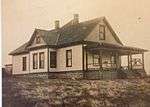Folk Victorian
Folk Victorian is an architectural style employed for some homes in the United States between 1870 and 1910, though isolated examples continued to be built well into the 1930s. Folk Victorian is a subset of Victorian architecture. It differentiates itself from other subsets of Victorian architecture (such as Queen Anne) by being less elaborate and having more regular floor plans.[1] Examples include the Bacon Hotel, Albert Spencer Wilcox Beach House, Lost Creek Baltimore and Ohio Railroad Depot (1892), James B. Carden House (1885), Ephriam M. Baynard House, and Sibley's General Store (1899) in the Sibley's and James Store Historic District.
 Midwestern home built in 1904. Modest exterior, interior features much woodwork
Midwestern home built in 1904. Modest exterior, interior features much woodwork- The Orin Jordan House in Whittier, California is an example of a Folk Victorian
 Early Folk Victorian home in Elgin, TX (Side Gable, Hall & Parlor design)
Early Folk Victorian home in Elgin, TX (Side Gable, Hall & Parlor design)
See also
- Stick-Eastlake architecture in the United States
- Victorian architecture in the United States
References
- 1870 - 1910: Folk Victorian; Vernacular Architecture From the Machine Age by Jackie Craven About.com
This article is issued from Wikipedia. The text is licensed under Creative Commons - Attribution - Sharealike. Additional terms may apply for the media files.